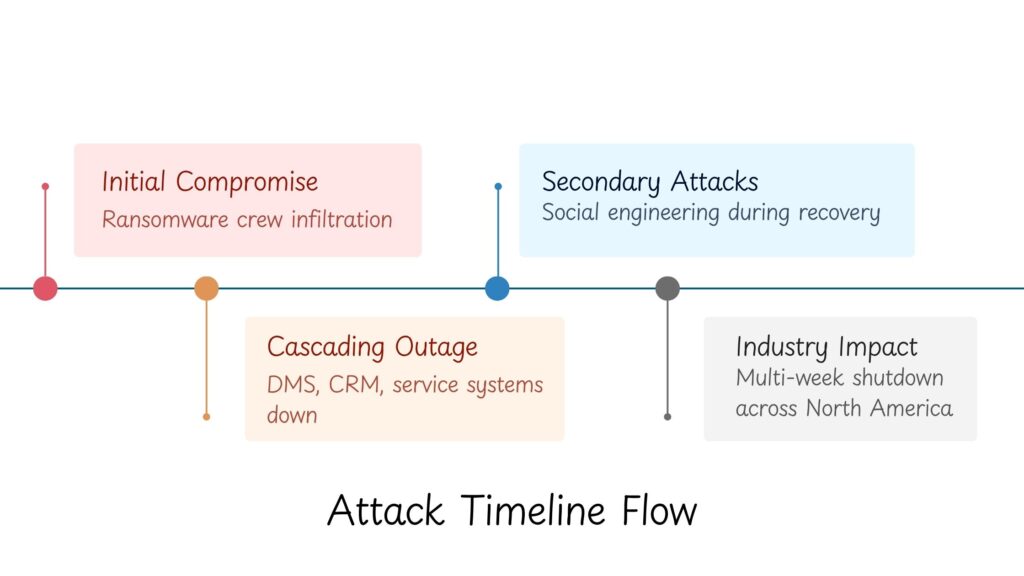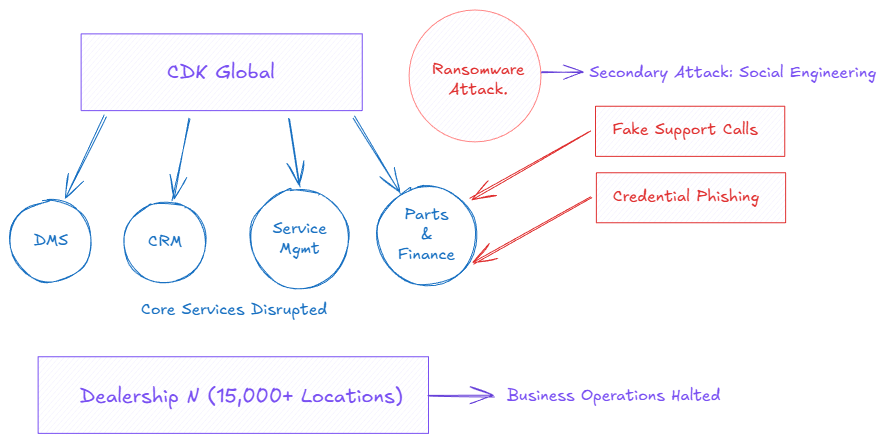CDK Global Cyber Attack – What Happened And How to Mitigate

If you work anywhere near automotive retail, the June 2024 CDK Global Cyber Attack didn’t read like news, it felt like a power outage that stretched for days across an entire city.
This wasn’t a single-dealer ransomware scare; it was a supply-chain event that rippled across roughly 15,000+ locations in North America and reminded everyone of a hard truth: in a software-defined dealership, your vendor is part of your attack surface.
Table of Contents
This article is the expert overview I wish every OEM, dealer group, and automotive SaaS provider reads.
We’ll walk through how the CDK global cyber attack happened, why the blast radius grows so quickly, what the aftermath teaches us about Human Risk, and the concrete steps the industry can take, starting with˳ continuous, AI-powered phishing simulation, to harden the people layer and reduce the probability that a single phish becomes a multi-week shutdown.

The Anatomy of a Cascading Outage by CDK Global Cyber Attack
In CDK’s case, public reporting pointed to a known ransomware crew, a proactive shutdown to contain spread, and even a second strike while recovery was underway—an especially cruel, but common, tactic because defenders are rushed, tired, and operating partially blind during restoration windows.
What made the outage so disruptive wasn’t only the malware. It was concentration of dependency. Dealer Management Systems (DMS), CRM, service scheduling, parts, and finance tooling aren’t “nice to have” utilities; they’re the nervous system of the dealership. When a vendor sits in the middle of those workflows, a single compromise becomes a distributed outage for thousands of businesses. If you run a parts counter, you don’t care whether the database server lived in your building or a vendor’s cloud—you just see a line of customers and a terminal that won’t cooperate.
Then came the secondary wave: social engineers impersonating vendor support. In the fog of recovery, with everyone desperate for normalcy, fake “CDK” callers asked for remote access and credentials. This is a human-layer attack pattern we see after almost every large breach. The psychology is simple: stress narrows attention, and official-sounding help is hard to resist when revenue is bleeding.
The human layer is the true perimeter
If you strip away the brand names and the headlines, incidents like the CDK Global incident still hinge on the oldest variable in security: people.. Yes, segmentation, backups, and identity controls matter (we’ll get to those). But the first domino often falls because someone, somewhere, responded to the wrong email, the wrong MFA prompt, or the wrong phone call. The lesson is not to shame users—it’s to train the muscle continuously and measure it like any other risk.
Classic security awareness programs are quarterly pep talks and annual modules. Attackers don’t schedule their campaigns around your LMS. In dealership land, where roles are specialized and turnover can be brisk, a one-size-fits-all training rhythm is neither realistic nor effective. Finance & Insurance teams see different lures than service writers. Parts and vendor coordinators are targeted with invoices, shipments, and supplier portals. Executives and their assistants get VIP wire approvals and media “briefings.” The only way to build durable reflexes is continuous, role-aware simulation that looks and feels like the phishing of today, not last year.
This is where AI-powered phishing simulation earns its keep. An agent that understands the dealership calendar (month-end pushes, model-year rollovers), local context (regional holidays, shipping themes), and behavior history can craft believable tests weekly, not yearly, and steadily reduce click-through without harassing staff. More important, it can deliver just-in-time micro-training and automatically retest clickers so we don’t confuse activity (watching a video) with outcome (fewer risky clicks). The output shouldn’t be a pretty pie chart; it should be a Human Risk Number—a live score you can show to a GM or CISO that moves as people improve.
What the aftermath taught the automotive industry
Hackers are increasingly targeting automotive industry, the CDK Global incident exposed a few patterns that the automotive ecosystem should treat as standing orders:
Vendor trust must be earned with evidence, not brochures
If a platform sits on your critical path, require more than SOC 2 PDFs and uptime SLAs. Ask for time-to-evidence commitments: when something goes wrong, how quickly can they produce artifacts (timelines, tickets, takedown receipts, before/after screenshots) you can show to auditors, insurers, and your own leadership? Evidence is the language of credibility.
Recovery is an attack window
Expect follow-on social engineering every time an incident makes the rounds. Publish an Official Channels page (verified URLs, sender domains, phone numbers) and train staff to verify any “support” call against that list. Run a drill now—literally hand someone a script—and see how easy it is to do the right thing under pressure.
Identity is the blast multiplier
Least privilege, MFA everywhere, conditional access, just-in-time privilege elevation, …and aggressive token rotation after the CDK Global incident are not ‘nice to have.’ They’re the difference… between a contained workstation issue and a cross-tenant service outage.
Segmentation and fail-operational plans matter
Segment vendor remote access from internal dealer networks. Pre-plan manual fallbacks for sales, parts, service, and F&I—then rehearse them. If your team has never printed a hand-written RO or closed a deal without a DMS, don’t wait until the lights go out to learn.
Communication decides your reputation
Customers forgive outages more easily than silence or spin. Draft templates now for “systems degraded,” “manual processing,” and “security event under investigation.” Clarity wins when adrenaline spikes.
A practical blueprint for dealerships and automotive SaaS providers to mitigate Human Risk
You don’t need a seven-figure program to make meaningful progress in ninety days. You need a focused plan and measurable goals. Here is a realistic sequence we’ve deployed across regulated and enterprise environments that maps well to automotive:
Days 0–7: Baseline and boundaries
- Stand up AI-powered phishing simulation for two cohorts (e.g., F&I and service advisors) as learned from the CDK Global Cyber Attack. Establish your Human Risk Number within the first week.
- Publish an internal Official Channels page and push it to every desk and shared device.
- Inventory vendor remote access paths and ensure MFA + conditional access across them.
Days 8–30: Prove outcomes quickly
- Run weekly simulations; begin micro-training + retests for clickers. Track report-rate and reward good reporters.
- For SaaS vendors: execute a 48-hour external surface scan of your public attack surface (domains, subdomains, portals). Close the Top 10 externally exploitable issues and verify fixes automatically.
- Draft a recovery “play card” that includes who speaks to whom, in what order, and what artifacts to collect.
Days 31–60: Standardize and extend
- Expand phishing cohorts to parts and back office; localize lures.
- Introduce DMARC+ work: inventory all senders (marketing platforms, service update mail, finance partners) and start alignment.
- If you’re an automotive SaaS, wire brand monitoring to detect look-alike domains and execute takedowns with platform-native notices. Build the habit of evidence-by-default—no closure without before/after proof.
Days 61–90: Industrialize
- Export a quarter-end evidence pack: campaign configs, timelines, outcomes, and improvements.
- Review vendor contracts and add a time-to-evidence SLA.
- Tabletop a “support call impostor” scenario with frontline staff and measure how quickly a fake gets spotted and escalated.
You’ll notice this plan is light on buzzwords and heavy on proof. That’s on purpose. Boards, insurers, OEM security reviewers, and regulators all ask the same question in different accents: “Show me.”
Where Hunto AI fits (kept focused and useful)
Hunto AI’s Human Risk module exists for exactly this kind of real-world environment—busy retail operations with specialized roles and little patience for security theater. Our agent runs continuous, role-aware phishing simulations, generates believable lures (invoice mismatches, vendor portal resets, shipping updates)—all tactics that proved effective during the CDK Global incident, delivers two-minute micro-training after risky actions, and automatically retests to confirm behavior change.
Most programs see a Human Risk Number in 7 days, 40–60% reduction in click-through within 90 days, and a 2–3x increase in report-rate as good habits take hold. Every campaign produces time-stamped, audit-ready evidence you can hand to internal audit, insurers, or OEM compliance teams without spinning up a war room.
If you’re a software vendor to dealerships, Hunto adds two more agents that round out the defensive picture without adding headcount: Brand Monitoring + Takedown (for fast removal of look-alike domains, fake apps, and scam ads with proof of action) and DMARC+ (to safely drive email authentication to p=reject so spoofed messages die at the perimeter). For organizations with strict data boundaries, we deploy dedicated, on-prem agents so models, prompts, and artifacts remain within your control.
The uncomfortable, but useful question to ask this week
If the exact same conditions that allowed CDK to be compromised were present in your dealership group or your SaaS stack today, what is the earliest moment you would have known, and what is the first artifact you could show to prove your response?
If the answers are “after customers called” and “a Slack thread,” you’ve just discovered your next sprint goals.
The CDK incident will not be the last time the industry feels a tremor.. It doesn’t have to collapse the skyline. Strengthen the human layer with continuous, AI-driven simulations that create measurable habits. Demand evidence-backed outcomes from your vendors. Treat identity as the new perimeter. Rehearse recovery and communication before you need them. And whenever possible, choose tools that do the work and prove it, not platforms that hand you prettier dashboards and more tickets.
If you want a low-friction starting point, we’ll run a 14-day Human Risk pilot for two cohorts and deliver a baseline Human Risk Number, improvement plan, and a sample evidence pack you can use with leadership. Whether you use Hunto or build your own approach, commit to outcomes you can show on paper. That’s how you keep the lights on, even when the wider grid flickers.